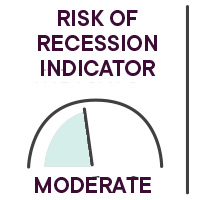Yann Furic
B.B.A., M. Sc., CFA®
Senior Portfolio Manager, Asset Allocation and Alternative Strategies
The Fed continues to surprise
The key event in June was certainly the meeting of the U.S. Federal Reserve (Fed). As expected, no rate hike was announced, but the forecast now includes a planned increase in 2023, which is sooner than expected.
Focus on the past month

Overview of global equity markets*
- The flagship index of the Canadian stock market, the S&P/TSX, advanced 2.5% in June.
- In the United States, the S&P 500 gained 5.4% and the Nasdaq, 8.8%.
- International stock markets were also in positive territory during the month, with the EAFE Index up 1.69%.
- Emerging market equities rose 3.0% in June, while Chinese stocks were up 2.9%.
* All the percentages in this section are in Canadian dollars. Bloomberg unless otherwise indicated.
Key events
Shift in interest rates
The Fed’s announcement that it would move up the date of its first rate hike resulted in a significant change in the yield curve. Short-term rates remained stable and long-term rates fell. For months now, the spread between long-term rates and short-term rates has widened, favouring economic recovery stocks. This turnaround favoured growth stocks, such as those of large U.S. technology companies.
Two investment styles
Driven by accommodative central banks and governments deploying pro-cyclical fiscal policies, the economic recovery is generally leading to two styles of investment:
- The first focuses on more cyclical stocks like those in the oil sector, financials, base metals and industrial products. This situation favours Europe, Japan, emerging economies (in part), small caps, Canada and Australia. As for the U.S. dollar, it is weakening against other currencies.
- Conversely, large cap stocks and growth stocks benefit from a slowdown in overall growth, but also from the spread of the Delta variant and less accommodative central bank policies.
The following table illustrates returns before and after the Fed meeting.
| Returns of the main indices | Period 1 | Period 2 |
| Indices | January 1 to June 15, 2021 | June 16 to 30, 2021 |
| S&P/TSX | 17.49 | -0.16 |
| Russell 2000 | 12.64 | 1.27 |
| S&P 500 | 8.77 | 2.96 |
| MSC World ex-US | 8.55 | -1.25 |
| Nasdaq-100 | 4.37 | 5.44 |
| MSCI Emerging Markets | 2.73 | 1,63 |
| All figures are in Canadian dollars and include dividends. | ||
| Source: Bloomberg. | ||
The markets are therefore swinging between these two styles (value and growth) and this should continue over the coming months. The spread of COVID-19 variants and the growth of inflation, as well as the recovery of the labour market, will be the decisive factors driving the markets.
COVID-19 and vaccination campaigns
Overall, vaccination is well underway, but immunization coverage differs from country to country, limiting a synchronized global economic recovery. In addition, fears over the rapid spread of the Delta variant and the strict lockdown of the city of Melbourne, Australia, show that the pandemic isn’t over, a situation which is undermining investor confidence.
China clamps down
China decided to tighten the screws on Chinese companies wanting to list on U.S. exchanges, citing, among other things, information security. Since last November, it has attempted to limit the influence of technology companies, while retaining some control over data. As a result, to be able to continue its activities, Ant Financial (a fintech company which is a subsidiary of the Chinese giant Alibaba) had to cancel its IPO (initial public offering) and comply with the banking regulators of its home country.
CPI on the rise
The Canadian Consumer Price Index has risen 3.6% over the past year, beating expectations of 3.5%. As in the United States, the question is whether inflation is transient or permanent.
Weak retail sales
April retail sales in Canada were down 5.7%, when forecasts were for a decline of 4.9%. The March numbers were revised upwards from a 3.6% increase to 4.5%. The return to lockdown of some provinces in recent months has had a negative effect on sales across the country.
Corporate earnings
U.S. earnings forecasts were revised upwards, which is positive for the markets.
Employment situation
In the United States, job creation was stronger last month with 850,000 new jobs, compared to the forecast of 720,000.
In Canada, 230,700 jobs were created, versus an expected gain of 175,000. At 7.8%, the unemployment rate was down 0.4%, while the labour force participation rate increased to 65.2% from 64.6% a month earlier.
Results – Canadian bonds
Government of Canada bonds across maturities posted a positive return of 0.6% for the month. (Source: Canaccord Genuity)
Performance of our funds
View the returns

Our strategic monitoring
Main risks
Here are some risks that we are closely monitoring in the current environment.
- The cyclical recovery could be limited or delayed by various vaccination campaign problems or by the spread of variants.
- A large-scale cyberattack could undermine the positive perception of the reopening of the global economy and consumer confidence.
- A strong rise in inflation without economic growth could trigger an episode of stagflation.
- A sharp, rapid rise in interest rates that lowers the price/earnings ratio could cause stock indices to fall.
- Corporate and personal tax rates could be raised to reduce government deficits, but this scenario is unlikely in 2021.
Fundamental indicators
Some economic indicators that we continued to monitor in June:
Consumer confidence ![]()
The Consumer Confidence Index remained above 100 in June for a fourth consecutive month.
U.S. personal savings ![]()
Already estimated at around $1.5 trillion at the end of 2020, U.S. personal savings grew significantly thanks to various government assistance programs. This money should be reinvested in the U.S. economy in the coming months, as life gradually returns to normal.
Global Purchasing Managers’ Index ![]()
The index remains above 50, indicating an increase in purchasing managers’ intentions. At 56.6, the index is lower than May’s 58.5 reading but is still positive.
Benchmark rates in Canada, Europe and the United States ![]()
Rates remain at low levels, which is favourable for an economic recovery. This situation should continue until economies return to a satisfactory rate of growth and a low unemployment rate. Central banks are still willing to let inflation exceed targets before tightening their monetary policies. Rate hikes could, however, come quicker than expected a few months ago, as the Fed’s forecasts demonstrate.
François Landry
CFA®
Vice-President and Chief Investment Officer
Vice-Chairman of the Board of Directors of Professionals' Financial - Private Management
Our strategies
(6-to-12 month horizon)
The strategic target deviation for the FDP Tactical Asset Allocation Private Portfolio is currently 65% equities and 35% bonds (versus the original target of 55% equities and 45% bonds). In light of market movements, the equity weighting was increased to 69% and the bond weighting reduced to 31%.
The geographic allocation of equities in our portfolios shows greater exposure to cyclical sectors. Canada and the EAFE zone are now overweighted, and our U.S. equity position is neutral. However, sector or factor positioning varies from region to region. By maintaining our exposure to technology stocks and a neutral weighting in the United States, we lessened the shock created by the Fed which favoured growth stocks during the second part of June. We will stick with our barbell strategy (50% short-term issues and 50% long-term, which enables us to profit from interest rate fluctuations).
- In terms of Canadian equities, we have had a favourable bias towards banks for several months and we maintained our exposure to financial services. Over the next few months, Canadian banks should obtain regulatory authorization to raise their dividends and resume share buybacks.
- Regarding U.S. equities, our exposure to stocks in the technology and industrial products sectors remains unchanged. We initiated a position in copper producers, as demand for this metal should benefit from announced spending targeting renewable energies. Increased demand for electric vehicles, which require more copper than internal combustion vehicles, will also favour these companies.
- As for the EAFE Index (Europe, Australasia, Far East), we now have an overweight position due to the index’s greater exposure to more cyclical sectors. The fiscal and monetary measures introduced in Europe are less aggressive than those implemented in North America, but the zone should nevertheless benefit from an increase in commodity prices.
François Landry, CFA
Vice-President and Chief Investment Officer
Yann Furic, B.B.A., M. Sc., CFA
Senior Portfolio Manager, Asset Allocation and Alternative Strategies
Sources: Bloomberg
The opinions expressed here and on the next page do not necessarily represent the views of Professionals’ Financial. The information contained herein has been obtained from sources deemed reliable, but we do not guarantee the accuracy of this information, and it may be incomplete. The opinions expressed are based upon our analysis and interpretation of this information and are not to be construed as a recommendation. Please consult your Wealth Management Advisor.










